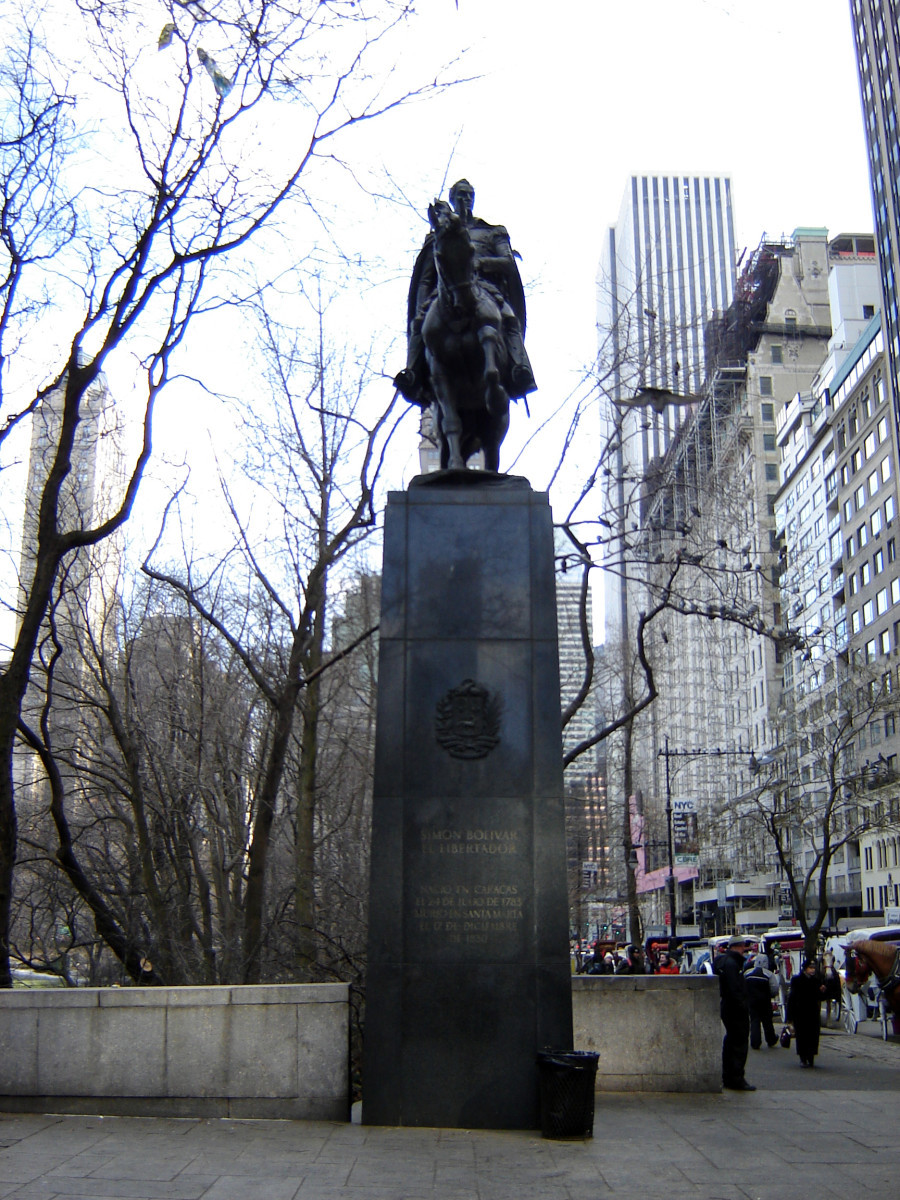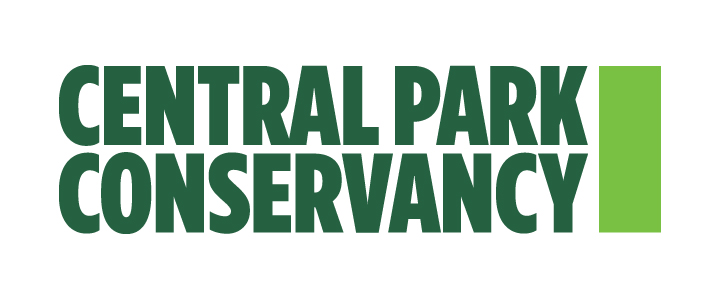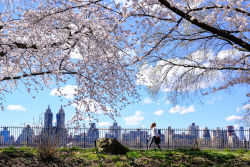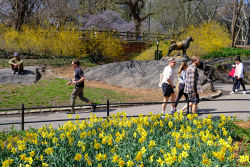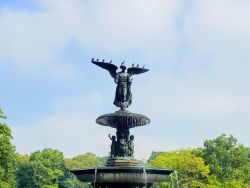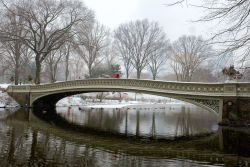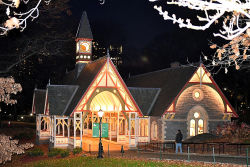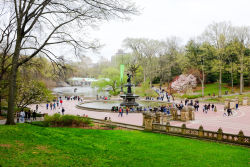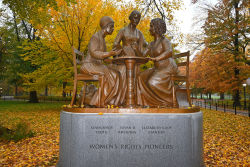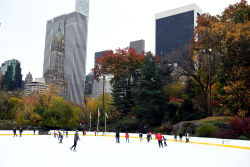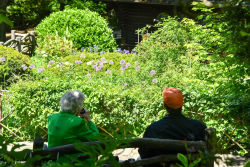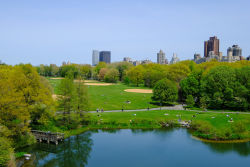Central Park
View all monuments in NYC Parks, as well as temporary public art installations on our NYC Public Art Map and Guide.
Simon Bolivar Monument
| Artist: | Sally Jane Farnham |
| Dedicated: | April 19, 1921 |
| Location: | Central Park South and Avenue of the Americas |
Artwork History
One of a trio of bronze equestrian sculptures representing Latin American leaders, the Simon Bolivar statue commemorates a military general and advocate of Pan-Americanism. Bolivar (1783-1830) is credited with the liberation from Spanish domination of Venezuela, Colombia, Ecuador, Peru, Bolivia, and Panama.
R. De Las Cora designed the first statue of Simon Bolivar that was installed in Central Park in 1891 on a knoll near West 83rd Street, dubbed “Bolivar Hill.” Critics of the statue believed it did not live up to the original artistic vision and it was subsequently removed at the direction of the Park Board. Sculptor Giovanni Turinni submitted a second interpretation of Bolivar in 1897, but it was rejected by the National Sculpture Society, which at that time advised the Board on sculpture installations.
In 1916, the Venezuelan government sponsored a worldwide competition to select a sculptor to render Bolivar. From 20 entrants, the committee selected Sally James Farnham (1876-1943), a relatively unknown sculptor. Farnham’s statue depicts Bolivar in full military dress upon his steed, which has its hoofs in the air. The sculpture was dedicated at Bolivar Hill on April 19, 1921. United States President Warren G. Harding (1865-1923), who spoke at the event, used the occasion to deliver a major policy address in which he urged greater cooperation between North and South America.
In 1945, Sixth Avenue was renamed Avenue of the Americas at the suggestion of Mayor Fiorello H. LaGuardia (1882-1947), to honor Pan-American ideals and principles. A new plaza was designed where the avenue meets Central Park. The statue of Bolivar was moved to the eastern side of the plaza, placed on a new black granite pedestal designed by the firm of Clarke and Rapuano, and rededicated on April 19, 1951. A month later, the statue of Argentine general Jose de San Martin was unveiled on the plaza’s west side, and in 1965 the dynamic statue of Cuban poet and activist Jose Marti was dedicated between the two earlier works.
In 1988, the Simon Bolivar statue was conserved through the Adopt-A-Monument Program, a joint venture of Parks, the Municipal Art Society, and the New York City Art Commission. The restored statue, now maintained by the Central Park Conservancy, remains a tangible symbol of the independence of Latin America.
Artwork Details
| Description: | Equestrian statue (heroic scale) on pedestal with four coats of arms |
| Architect: | Clarke & Rapuano |
| Materials: | Statue and coats of arms--bronze; Pedestal--black granite (polished) |
| Dimensions: | Statue H: 13'6" L: 13'; Pedestal H: 20'4" L: 12'6" W: 6'1" |
| Donor: | Government of Venezuela |
| Cast: | 1919 |
Inscription
SIMON BOLIVAR / EL LIBERATOR /---/ VENEZUELA A LA CIUDAD / DE NUEVA YORK /---/ LIBERTADOR DE VENEZUELA / NUEVA GRANADA / ECUADOR, PERU / FUNDADOR DE BOLIVIA / ---/ NACIO EN CARACAS / EL 24 DE JULIO DE 1783 / MURIO EN SANTA MARTA / EL 17 DE DICIEMBRE DE 1830Please note, the NAME field includes a primary designation as well as alternate namingsoften in common or popular usage. The DEDICATED field refers to the most recent dedication, most often, butnot necessarily the original dedication date. If the monument did not have a formal dedication, the yearlisted reflects the date of installation.
For more information, please contact Art & Antiquities at (212) 360-8163.
Check out your park's Vital Signs
Clean & Safe
Green & Resilient
Empowered & Engaged Users
Share your feedback or learn more about how this park is part of a
Vital Park System
Contacts
Central Park Information: (212) 310-6600
Central Park Information (for the Hearing Impaired): (800) 281-5722
Belvedere Castle, The Henry Luce Nature Observatory: (212) 772-0210
The Charles A. Dana Discovery Center: (212) 860-1370
The Dairy Visitor Center and Gift Shop: (212) 794-6564
North Meadow Recreation Center: (212) 348-4867
Loeb Boathouse (Bike rentals, boat rentals & gondolas): (212) 517-2233
Carousel: (212) 879-0244
Fishing at Harlem Meer (Catch & Release): (212) 860-1370
Harlem Meer Performance Festival: (212) 860-1370
Horseback Riding - Claremont Stables: (212) 724-5100
Metropolitan Opera (Performances on the Great Lawn): (212) 362-6000
New York Philharmonic (Performances on the Great Lawn): (212) 875-5709
Shakespeare in the Park - The Public Theater at the Delacorte Theater: (212) 539-8655
Central Park SummerStage: (212) 360-2777
Swedish Cottage Marionette Theater: (212) 988-9093
Tennis: (212) 280-0205
Weddings, Ceremonies and Photography at the Conservatory Garden: (212) 360-2766
Wildlife Center & Tisch Children's Zoo: (212) 439-6500
